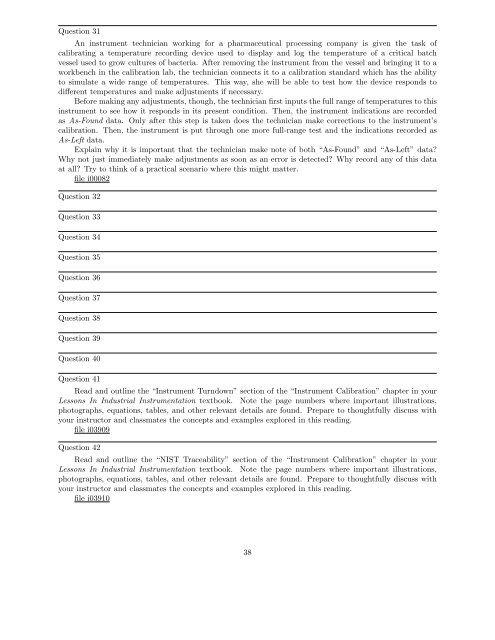INST 262 (DCS and Fieldbus), section 2 Lab Automatically ...
INST 262 (DCS and Fieldbus), section 2 Lab Automatically ...
INST 262 (DCS and Fieldbus), section 2 Lab Automatically ...
Create successful ePaper yourself
Turn your PDF publications into a flip-book with our unique Google optimized e-Paper software.
Question 31<br />
An instrument technician working for a pharmaceutical processing company is given the task of<br />
calibrating a temperature recording device used to display <strong>and</strong> log the temperature of a critical batch<br />
vessel used to grow cultures of bacteria. After removing the instrument from the vessel <strong>and</strong> bringing it to a<br />
workbench in the calibration lab, the technician connects it to a calibration st<strong>and</strong>ard which has the ability<br />
to simulate a wide range of temperatures. This way, she will be able to test how the device responds to<br />
different temperatures <strong>and</strong> make adjustments if necessary.<br />
Before making any adjustments, though, the technician first inputs the full range of temperatures to this<br />
instrument to see how it responds in its present condition. Then, the instrument indications are recorded<br />
as As-Found data. Only after this step is taken does the technician make corrections to the instrument’s<br />
calibration. Then, the instrument is put through one more full-range test <strong>and</strong> the indications recorded as<br />
As-Left data.<br />
Explain why it is important that the technician make note of both “As-Found” <strong>and</strong> “As-Left” data?<br />
Why not just immediately make adjustments as soon as an error is detected? Why record any of this data<br />
at all? Try to think of a practical scenario where this might matter.<br />
file i00082<br />
Question 32<br />
Question 33<br />
Question 34<br />
Question 35<br />
Question 36<br />
Question 37<br />
Question 38<br />
Question 39<br />
Question 40<br />
Question 41<br />
Read <strong>and</strong> outline the “Instrument Turndown” <strong>section</strong> of the “Instrument Calibration” chapter in your<br />
Lessons In Industrial Instrumentation textbook. Note the page numbers where important illustrations,<br />
photographs, equations, tables, <strong>and</strong> other relevant details are found. Prepare to thoughtfully discuss with<br />
your instructor <strong>and</strong> classmates the concepts <strong>and</strong> examples explored in this reading.<br />
file i03909<br />
Question 42<br />
Read <strong>and</strong> outline the “NIST Traceability” <strong>section</strong> of the “Instrument Calibration” chapter in your<br />
Lessons In Industrial Instrumentation textbook. Note the page numbers where important illustrations,<br />
photographs, equations, tables, <strong>and</strong> other relevant details are found. Prepare to thoughtfully discuss with<br />
your instructor <strong>and</strong> classmates the concepts <strong>and</strong> examples explored in this reading.<br />
file i03910<br />
38


